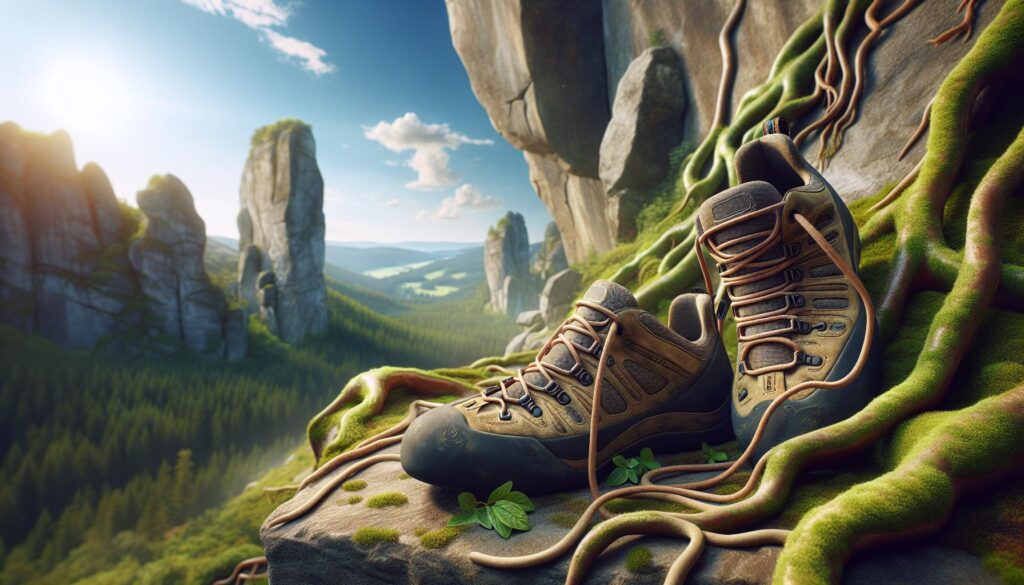Climbing shoes may stretch, but the extent of stretching depends on the shoe’s material and construction. Climbing shoes are an essential piece of equipment for both indoor and outdoor rock climbing.
These specialized shoes are designed to provide climbers with superior grip and precise foot placement on various surfaces. However, many climbers wonder if their climbing shoes will stretch over time. The answer to this question is not a simple yes or no.
While climbing shoes may stretch, the degree of stretching will vary depending on the shoe’s material and construction. We will explore the factors that contribute to stretching in climbing shoes and provide tips on how to properly fit your shoes for optimal performance.

Credit: www.outdoorgearlab.com
Table of Contents
The Basics Of Climbing Shoes
Climbing shoes are designed to provide grip and support while climbing various surfaces. There are different types of climbing shoes available, such as neutral, moderate, and aggressive. Neutral shoes are more comfortable for long climbs, while aggressive shoes offer better precision on difficult terrain.
It is important to find the right fit for your climbing shoes, as an ill-fitting shoe can cause discomfort and affect your performance. When trying on climbing shoes, ensure that they are snug but not overly tight. A tight fit allows for better control, while still allowing some movement of the toes.
It is worth noting that climbing shoes do stretch over time, but the amount of stretch depends on the material used. Leather shoes tend to stretch more than synthetic ones. Therefore, it is crucial to consider the material and fit when purchasing climbing shoes.
Will Climbing Shoes Stretch?
Climbing shoes are known for their stiffness and snug fit, but will they stretch over time? Understanding the stretching process of climbing shoes can help determine the answer. Several factors can affect the elasticity of climbing shoes. The type of material used, such as leather or synthetic materials, can impact how much the shoes stretch.
Additionally, the construction of the shoe, including the design of the upper and the type of closure system, can also play a role in its stretch potential. Furthermore, the wearer’s foot shape and the frequency and intensity of use can influence stretching.
It is important to note that while some shoes may stretch slightly, others may not stretch at all. Proper sizing and fit are crucial to ensure comfort and performance when climbing. Overall, it is essential to consider these factors when determining if climbing shoes will stretch for an individual.
How Much Do Climbing Shoes Stretch?
Climbing shoes do stretch to a certain extent, but the myth that they don’t stretch is not entirely accurate. The amount of stretch depends on various factors, such as the material and construction of the shoe. Typically, climbing shoes made from leather tend to stretch more than those made from synthetic materials.
On average, you can expect a stretch of about half a size to a full size. However, it’s important to note that not all shoes will stretch the same way or to the same degree. It’s advisable to try on different sizes and styles to find the perfect fit for your feet.
Remember, a properly fitting shoe is crucial for comfort and performance while climbing. So, don’t be afraid to experiment and find the right pair that suits your needs.
Factors Affecting The Stretchability Of Climbing Shoes
Climbing shoes do have the potential to stretch, but it depends on various factors. The material used in the construction of the shoes plays a crucial role in their stretchability. Different climbing shoe brands and models can have varying levels of stretchiness.
Some shoes are made from more flexible materials, allowing for better stretch, while others may be made from stiffer materials, providing less stretch. Additionally, the construction of the shoes, such as the type of stitching or the presence of overlays, can affect their stretch.
It’s important to consider these factors when choosing climbing shoes, as the level of stretch can impact fit and performance. Trying on different brands and models and consulting with experts can help determine the stretchability that suits your needs.
Can You Speed Up The Stretching Process?
Climbing shoes may stretch over time but can you speed up the stretching process? There are techniques that can help accelerate the stretching without compromising the integrity of the shoes. One method is by using a shoe stretcher, which can gradually widen the shoes to fit your feet better.
Another technique involves wearing the shoes with thick socks and heating them with a hairdryer to soften the materials. This enables the shoes to stretch more easily. Additionally, you can try soaking the shoes in warm water and wearing them until they dry completely.
This allows the shoes to conform to the shape of your foot. However, it’s important to note that excessive stretching can weaken the shoes, so it’s best to go slow and allow the shoes to adapt naturally over time. By following these techniques, you can ensure that your climbing shoes stretch comfortably and effectively.
How To Determine If Your Climbing Shoes Have Stretched
Determining whether your climbing shoes have stretched is crucial for evaluating the fit post-stretch. As climbers, we rely heavily on our footwear for optimal performance and safety. Signs that indicate stretching include a looser fit around the toes and heel, as well as less tension in the overall shoe shape.
Additionally, pay attention to any creases or wrinkles forming in the upper material. If you notice a significant change in the way your shoes feel on your feet, it may be a sign that they have stretched. It is important to regularly assess the fit of your climbing shoes to ensure proper support and functionality.
By staying aware of these indicators, you can make informed decisions about whether to replace your shoes or continue using them for your climbing endeavors. Remember, a well-fitting climbing shoe is essential for better performance and safety on the rock.
Tips For Properly Fitting Climbing Shoes
Finding the perfect fit for your climbing shoes is crucial to your performance on the wall. It’s important to have a snug yet comfortable fit to ensure optimal climbing ability and minimize discomfort. When choosing climbing shoes, consider the shape and size of your foot to find the most suitable option.
Avoid compromising on fit, as climbing shoes generally do not stretch significantly. Keep in mind that tight-fitting shoes provide better precision and responsiveness, whereas loose shoes may result in less control and slippage. Experiment with different brands and models to find the best fit for you.
Prioritize comfort and functionality to enhance your climbing experience and achieve your climbing goals. Remember, a well-fitting pair of climbing shoes can make all the difference in your performance and enjoyment on the wall.
Caring For Stretched Climbing Shoes
Climbing shoes can stretch over time due to continuous use and pressure on the material. Preventing this stretching requires proper care and maintenance. It is essential to preserve the shape of your climbing shoes to maintain their performance on the rock or wall.
Regularly cleaning the shoes and removing dirt and debris can help prevent stretching. Adequately storing them in a cool, dry place can also contribute to preserving their shape. Additionally, avoiding excessive heat and direct sunlight can prevent the rubber from softening and stretching.
When climbing shoes do stretch, appropriate treatment may restore their shape and performance. Techniques like wetting the shoes and wearing them while they dry can help shrink them back to their original size. Understanding the proper maintenance and treatment methods can extend the lifespan of climbing shoes and continue to provide optimal performance on your climbing adventures.
Do Climbing Shoes Eventually Lose Their Elasticity?
Climbing shoes inevitably lose some of their elasticity over time due to consistent use. Stretching is a natural consequence as the materials wear out, affecting the shoe’s fit and performance. While shoes can initially feel snug, factors such as foot sweat, weight exertion, and prolonged pressure contribute to their deterioration.
However, it’s worth noting that different types of climbing shoes may vary in their durability and stretchability. Stiffer shoes tend to retain their shape longer, while softer ones may stretch more quickly. It’s essential for climbers to understand the limits of stretching and consider their specific needs when choosing climbing shoes.
Regular inspections, proper care, and using shoe inserts can help extend the lifespan and maintain optimal performance. So, while climbing shoes may stretch, being aware of the contributing factors can help climbers make informed decisions regarding their equipment.
Frequently Asked Questions On Will Climbing Shoes Stretch
Are Climbing Shoes Supposed To Stretch?
Yes, climbing shoes can stretch slightly due to the materials used, but this varies depending on the brand and model.
Are Climbing Shoes Supposed To Be Tight?
Yes, climbing shoes should be tight to provide better control and prevent foot movement while climbing.
How Many Sizes Do Climbing Shoes Stretch?
Climbing shoes typically stretch half to one full size.
How Can I Make My Climbing Shoes Looser?
Loosen your climbing shoes by adjusting the straps or laces for a more comfortable fit.
Conclusion
The stretching capacity of climbing shoes depends on various factors such as the material used, the type of shoe, and how well they are maintained. Leather shoes tend to stretch more compared to synthetic ones. It is essential to consider the intended use of the shoes when deciding on the size.
For sport climbing or bouldering, a tighter fit may be preferred for better performance and precision. On the other hand, for long multi-pitch routes or trad climbing, a more comfortable fit is recommended to minimize discomfort. Regardless of the initial fit, it is important to break in climbing shoes gradually to allow them to mold to your feet without causing excessive pain or discomfort.
Regular cleaning and maintenance are also crucial to prolong the lifespan of your climbing shoes. Taking these factors into consideration will help you determine the right balance between comfort and performance, ensuring an enjoyable climbing experience.














